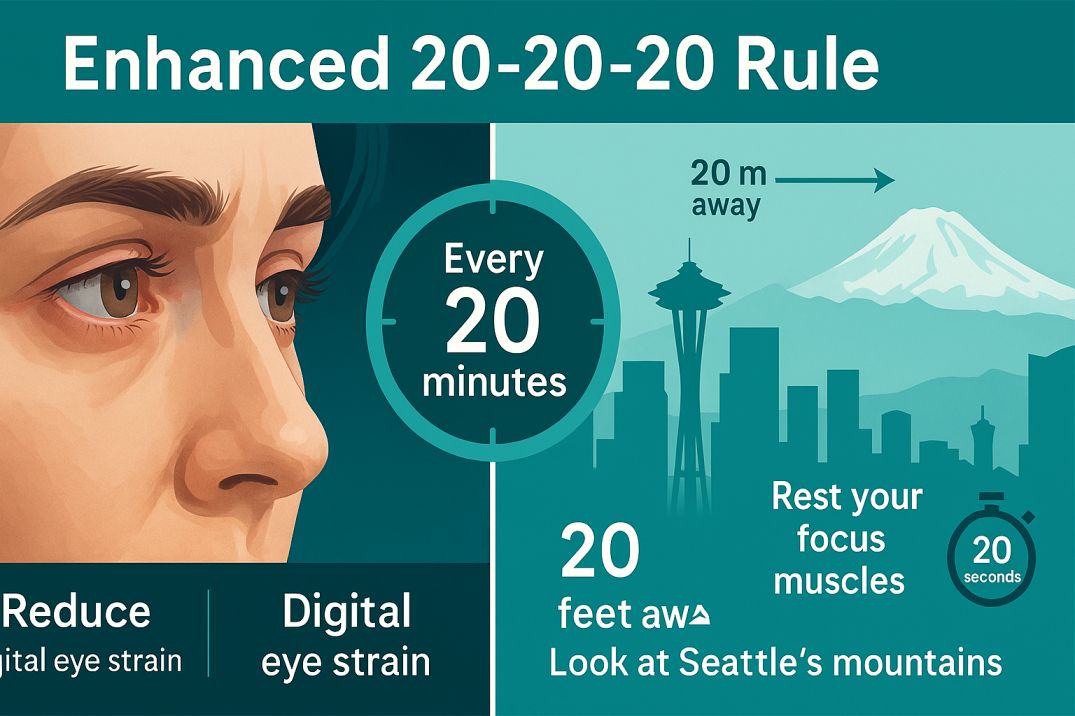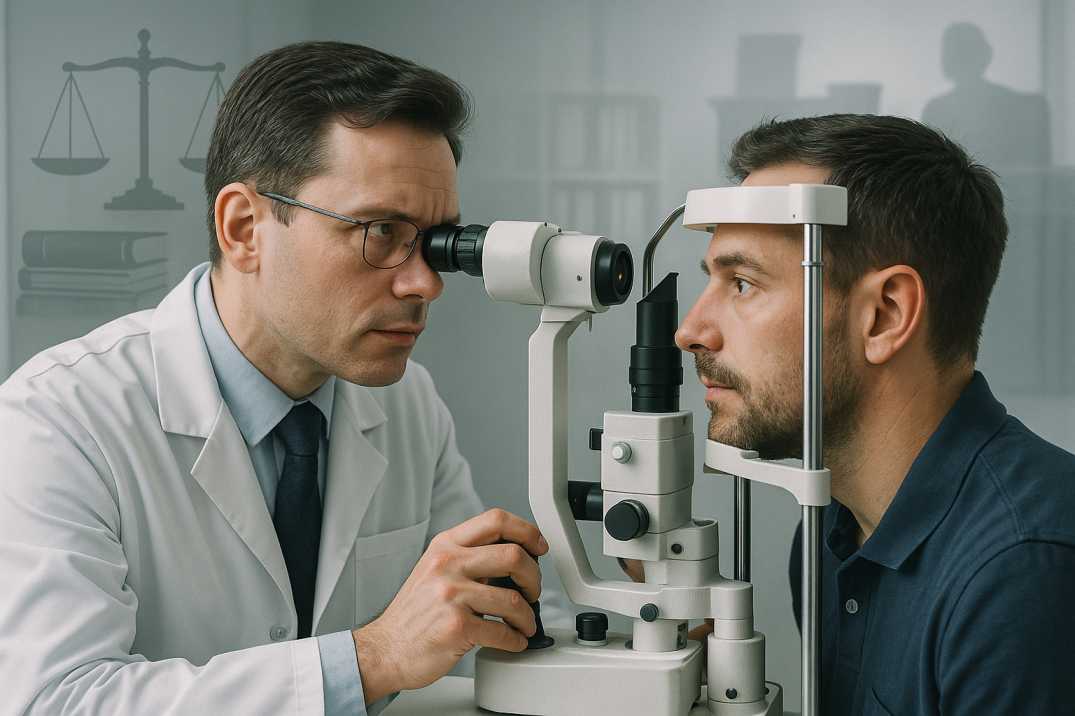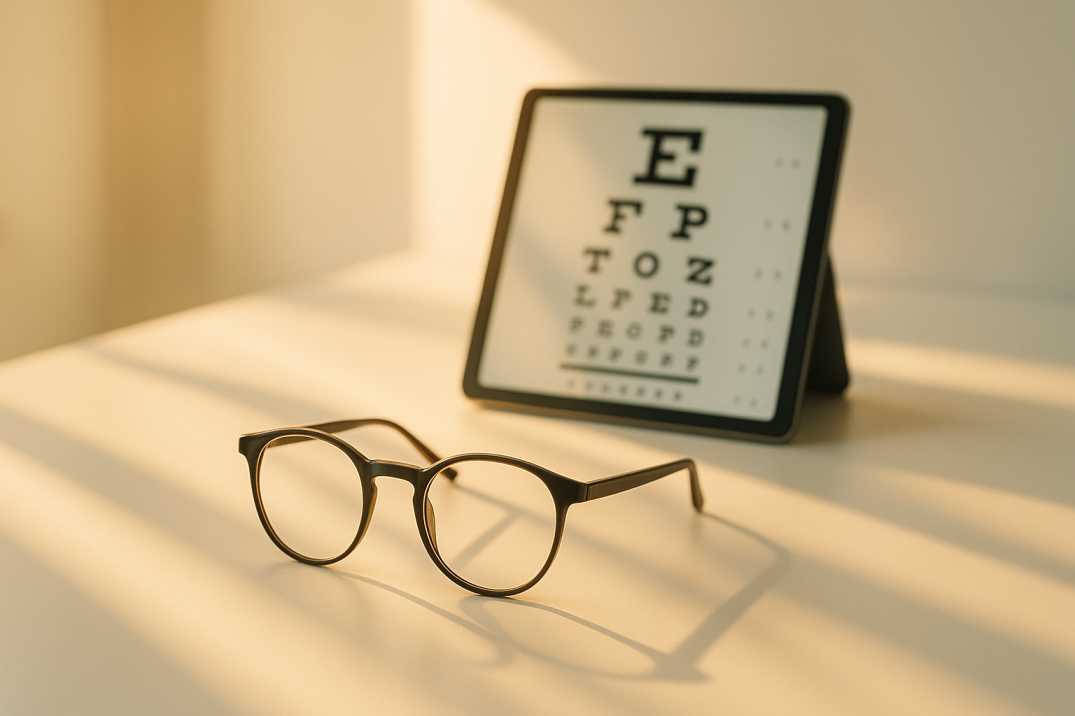7 Eye Health Resolutions Every Seattle Professional Should Make in 2025
Bottom Line Up Front: Seattle’s professional workforce faces unprecedented eye health challenges from digital screen time that averages 96+ hours weekly. These seven evidence-based eye health resolutions can protect your vision, boost workplace productivity, and prevent long-term complications—making them essential priorities for professional eye health in 2025.
Why Seattle Professionals Need Eye Health Resolutions Now More Than Ever
Seattle’s tech-driven economy has created a perfect storm for eye health challenges. With Amazon, Microsoft, and countless startups calling the Emerald City home, professional eye health has become a critical workplace wellness issue that can no longer be ignored.
Recent 2024 research from VSP Vision Care reveals alarming trends affecting Seattle’s professional workforce. 82% of Gen Z employees report working longer hours, including nights and weekends, and 54% say their eye health is worsening as a result. For Seattle professionals spending over 96 hours of screen time a week, with more than a third of that time coming from work, implementing effective eye health resolutions has never been more critical.
The impact extends far beyond discomfort. 50% of workers have at least one eye issue, for example blurred or poor vision, eye strain and fatigue, or dry and itchy eyes. Workers struggling with these issues report negative impacts on their productivity (63%), ability to focus (55%), and mental health (42%).
Resolution #1: Schedule Comprehensive Annual Eye Exams with Seattle Eye Care Specialists
The Foundation of Professional Eye Health
Your first and most crucial eye health resolution for 2025 should be committing to regular comprehensive eye examinations. Routine eye exams help detect vision changes early and provide valuable insights into overall health, as many eye conditions, such as glaucoma, cataracts, or retinal disorders, develop without noticeable symptoms.
What Makes Seattle Eye Care Comprehensive
Leading Seattle optometrists like those at Cannon EyeCare emphasize that comprehensive exams go far beyond basic vision testing. These evaluations include:
- Retinal photography to detect early signs of diabetes, hypertension, and neurological conditions
- Glaucoma screening using advanced pressure measurement and optic nerve analysis
- Dry eye assessment specifically crucial for Seattle’s computer-intensive workforce
- Digital eye strain evaluation tailored to your specific work environment
Seattle-Specific Benefits
Seattle professionals have access to some of the nation’s most advanced eye care technology. Practices in University Village, Pike Place Market, and throughout the greater Seattle area offer state-of-the-art diagnostic equipment that can detect health issues years before symptoms appear.
Action Steps:
- Schedule your 2025 eye exam before March to establish baseline measurements
- Choose a provider experienced with digital eye strain (common in Seattle’s tech sector)
- Ensure your insurance covers comprehensive exams (most Seattle employer plans do)
- Ask about workplace-specific vision assessments
Resolution #2: Master the 20-20-20 Rule for Professional Eye Health
Combat Computer Vision Syndrome Effectively
Computer Vision Syndrome is a growing health concern in the digital age, with a reported prevalence of 69.0%. For Seattle professionals, this statistic hits particularly close to home given the city’s concentration of knowledge workers and the need for proactive professional eye health strategies.
The Science Behind 20-20-20
The 20-20-20 rule is a simple, free and effective habit for screen users: every 20 minutes, look at something 20 feet away for at least 20 seconds. This brief pause relaxes the eye muscles, helping to prevent the discomfort, dryness, and blurred vision often associated with prolonged screen time.
Research from 2024 shows that screen time exceeding two hours daily has been consistently linked to a higher risk of CVS. With Seattle professionals averaging significantly more than this threshold, implementing the 20-20-20 rule becomes not just helpful, but essential.
Seattle Workplace Implementation
Given Seattle’s collaborative work culture, many companies are implementing team-based 20-20-20 reminders. Some innovative approaches include:
- Slack bots that remind entire teams to take eye breaks
- Calendar blocks for “vision wellness breaks”
- Standing desk rotations that naturally incorporate distance viewing
- Window placement strategies taking advantage of Seattle’s natural beauty for distance focusing
Enhanced Techniques for Tech Workers
Beyond basic 20-20-20, Seattle eye care specialists recommend:
- Blinking exercises (20 deliberate blinks every 20 minutes)
- Focus shifting between multiple distances
- Palming techniques for deeper eye muscle relaxation
- Screen positioning at 15-20 degrees below eye level
Resolution #3: Optimize Your Seattle Workspace for Eye Health
Creating Vision-Friendly Work Environments
The positioning of the computer screen is crucial for comfort and ergonomics. Users typically find it more comfortable when their eyes naturally look downward toward the screen. For optimal positioning, the screen should be set 15 to 20 degrees below eye level, with the center of the screen positioned about 4 to 5 inches below eye level and at a distance of 20 to 28 inches from the eyes.
Seattle-Specific Lighting Considerations
Seattle’s unique lighting conditions—from overcast winter days to brilliant summer sunshine—require special workspace considerations:
Winter Adaptations:
- Position screens perpendicular to windows to minimize glare
- Use full-spectrum lighting to compensate for reduced natural light
- Adjust screen brightness to match ambient lighting levels
- Consider seasonal light therapy for overall wellness
Summer Strategies:
- Install adjustable blinds or screens for intense Pacific Northwest summer light
- Use anti-glare screen filters during peak daylight hours
- Position monitors to avoid reflection from windows facing Elliott Bay or Lake Washington
Ergonomic Excellence for Seattle Professionals
Modern Seattle workspaces should incorporate:
- Monitor arms for easy height and angle adjustments
- Blue light filtering (though scientific evidence is mixed, some users report subjective comfort improvements)
- Proper keyboard positioning to reduce neck strain that affects eye comfort
- Dual monitor setups positioned at equal distances and heights
Action Steps:
- Conduct a workspace audit using OSHA’s computer workstation checklist
- Measure your current screen distance and adjust to optimal 20-28 inches
- Evaluate lighting throughout different times of day
- Consider investing in ergonomic equipment through your employer’s wellness program
Resolution #4: Address Dry Eye Syndrome as Part of Your Eye Health Resolutions
Seattle’s Hidden Eye Health Epidemic
Dry eye syndrome affects millions of professionals nationwide, but Seattle’s unique climate and work environment create particular challenges. Conservative prevalence estimates suggest that 10-20% of the population over 40 years of age report moderate to severe dry eye symptoms, with higher rates among women and those with extensive screen time, making proactive management crucial for Seattle’s professional eye health initiatives.
Understanding Modern Dry Eye
Dry Eye Syndrome is a condition where the tear film that normally hydrates the surface of the eye is chronically disrupted. The tear film consists of several layers, including the aqueous layer that provides nutrients to the eye, and the oil layer that prevents the aqueous layer from evaporating off the eye.
Seattle-Specific Risk Factors
Seattle professionals face unique dry eye challenges:
- Indoor heating systems during long rainy seasons
- Air conditioning in modern office buildings
- Prolonged screen use reducing blink rates by up to 60%
- Contact lens wear common among active Seattle professionals
- Coffee consumption (sorry, Seattle!) which can contribute to dehydration
Professional Treatment Options in Seattle
Leading Seattle eye care specialists offer advanced treatments:
Conservative Approaches:
- High-quality omega-3 supplementation
- Preservative-free artificial tears
- Warm compress therapy
- Eyelid hygiene protocols
Advanced Therapies Available in Seattle:
- Intense Pulsed Light (IPL) therapy for meibomian gland dysfunction
- TearCare treatments for oil gland restoration
- Punctal plugs for tear retention
- Prescription anti-inflammatory drops like Restasis or Xiidra
Implement these evidence-based approaches:
- Humidification: Maintain 40-50% humidity in your workspace
- Nutrition: Increase omega-3 fatty acids through diet or supplements
- Hydration: Aim for half your body weight in ounces of water daily
- Sleep hygiene: 7-8 hours of quality sleep supports tear production
Resolution #5: Prioritize Regular Exercise for Eye Health
The Vision-Fitness Connection
While often overlooked, regular exercise provides significant benefits for eye health—particularly relevant for Seattle’s health-conscious professional community.
Cardiovascular Benefits for Vision
Exercise improves blood flow to the retina and optic nerve, delivering essential nutrients and oxygen. This is particularly important for preventing:
- Age-related macular degeneration
- Diabetic retinopathy
- Glaucoma (exercise can help lower intraocular pressure)
- Hypertensive retinopathy
Seattle’s Outdoor Advantage
Take advantage of Seattle’s exceptional outdoor recreation opportunities:
Year-Round Activities:
- Hiking in the Cascades or Olympics (natural distance viewing exercises)
- Cycling around Green Lake or Burke-Gilman Trail
- Rowing on Lake Union or Lake Washington
- Rock climbing at local gyms (excellent for eye-hand coordination)
Vision-Specific Exercise Benefits
Research shows that regular physical activity:
- Reduces intraocular pressure by 20% in some individuals
- Improves blood flow to ocular tissues
- Helps maintain healthy body weight (reducing diabetes risk)
- Supports better sleep quality (crucial for eye health)
Workplace Integration
Many Seattle companies are embracing vision-health-supporting activities:
- Walking meetings around South Lake Union
- Bike-to-work programs with vision safety education
- Corporate gym memberships emphasizing eye health benefits
- Outdoor team-building activities in Washington’s natural areas
Resolution #6: Implement a Nutrition Plan for Optimal Eye Health
Feeding Your Vision
Eating a wide variety of fruit and vegetables, particularly leafy green veg like kale and spinach, may support good eye health and reduce the risk of macular degeneration. Following a healthy diet will also help maintain a healthy weight and keep blood pressure under control, reducing risk of conditions such as diabetes and stroke, which can affect vision.
Seattle’s Local Food Advantage
The Pacific Northwest offers exceptional access to eye-healthy foods:
Vision Superfoods Available in Seattle:
- Wild-caught salmon (omega-3 fatty acids for dry eye prevention)
- Organic kale and spinach (lutein and zeaxanthin for macular protection)
- Blueberries (anthocyanins for retinal health)
- Walnuts (additional omega-3 sources)
- Sweet potatoes (beta-carotene for overall eye health)
Professional Meal Planning
For busy Seattle professionals, consider:
Breakfast Options:
- Smoked salmon and spinach omelets
- Blueberry and walnut oatmeal
- Green smoothies with local kale
Lunch Solutions:
- Kale Caesar salads with grilled salmon
- Sweet potato and black bean bowls
- Seasonal vegetable soups from Pike Place Market
Dinner Ideas:
- Cedar plank salmon with roasted vegetables
- Quinoa bowls with local greens
- Grass-fed beef with sweet potato sides
Supplementation for Professionals
When whole foods aren’t always accessible, consider professional-grade supplements:
- AREDS2 formula for macular degeneration prevention
- High-quality omega-3s (aim for 1000mg EPA/DHA daily)
- Lutein and zeaxanthin (10mg and 2mg respectively)
- Vitamin D (particularly important in Seattle’s limited winter sun)
Resolution #7: Protect Your Eyes from UV Damage Year-Round
Seattle’s Surprising UV Risks
Many Seattle professionals underestimate UV exposure risks, assuming the city’s frequent cloud cover provides adequate protection. This misconception can lead to serious long-term eye damage.
Year-Round UV Protection Needs
Exposure to ultraviolet (UV) light from sunshine has been linked to eye conditions including cataract and potentially to age-related macular degeneration (AMD). Patients should make sure they have good quality, dark sunglasses with UV protection and the UKCA or CE mark. Exposure to winter sun can be just as damaging, so wearing sunglasses for winter driving in low sun which is more likely to cause glare, is just as important.
Seattle’s Unique UV Challenges
Winter Hazards:
- Low-angle sun creates intense glare during commutes
- Snow reflection on nearby mountains doubles UV exposure
- Clear winter days can be deceptively bright
- Driving conditions on I-5 and I-405 require UV protection
Summer Considerations:
- Seattle’s long summer days extend UV exposure hours
- Water reflection from Puget Sound and lakes intensifies UV rays
- High-altitude activities in the Cascades increase exposure
- Outdoor dining and events require consistent protection
Professional Eyewear Solutions
Invest in quality protective eyewear:
Daily Wear Options:
- Prescription sunglasses for outdoor meetings
- Photochromic lenses that adjust to lighting conditions
- Wraparound styles for comprehensive protection
- Polarized lenses for water and snow glare reduction
Activity-Specific Protection:
- Sports sunglasses for cycling and hiking
- Safety glasses with UV protection for outdoor work sites
- Driving glasses optimized for dashboard and road glare
- Computer glasses with slight UV filtering (though primary benefit is blue light management)
Creating Your 2025 Eye Health Action Plan
Monthly Implementation Strategy
January – Foundation Building:
- Schedule comprehensive eye exam
- Optimize workspace ergonomics
- Begin 20-20-20 rule implementation
February – Habit Formation:
- Establish consistent dry eye management routine
- Start nutrition improvements
- Implement UV protection habits
March – Exercise Integration:
- Add vision-supporting physical activities
- Join Seattle outdoor recreation groups
- Establish workplace wellness partnerships
Quarterly Check-ins:
Q1 Goals:
- Complete comprehensive eye exam
- Establish daily vision wellness routines
- Optimize workspace for eye health
Q2 Goals:
- Assess dry eye management effectiveness
- Evaluate nutrition plan success
- Review UV protection consistency
Q3 Goals:
- Monitor exercise routine benefits
- Adjust strategies based on summer conditions
- Plan for seasonal lighting changes
Q4 Goals:
- Prepare for winter lighting challenges
- Schedule follow-up eye care appointments
- Plan 2026 vision health goals
Seattle Eye Care Resources for Professionals
Leading Providers Specializing in Professional Eye Health:
- Cannon EyeCare (University Village & Pike Place Market): Known for comprehensive dry eye treatment and professional eye health
- Broadway Vision (Capitol Hill): Extensive experience with digital eye strain
- Eye Clinics of Seattle: Multiple locations serving Seattle professionals
- Oculus Eyecare (South Lake Union): Modern approach to tech worker eye health
Insurance and Employer Benefits:
Most Seattle employers offer vision benefits through:
Many plans cover annual comprehensive exams and provide allowances for corrective eyewear.
The Science Behind These Resolutions: Recent Research Support
Study 1: Workplace Vision Health Impact (2024)
Recent research from VSP Vision Care provides compelling evidence for workplace eye health initiatives. The study, which polled 800 human resource benefit leaders and 800 additional full-time employees at U.S. organizations, found that employees are getting over 96 hours of screen time a week, with more than a third coming from work. Remote and hybrid workers get more than 7 hours of screen time each day, compared to just 5.5 hours for on-site employees, highlighting the particular challenges facing Seattle’s hybrid workforce.
Study 2: Computer Vision Syndrome Global Prevalence (2023)
A comprehensive systematic review and meta-analysis published in the Journal of Optometry analyzed 103 cross-sectional studies with 66,577 participants and found that Computer Vision Syndrome affects 69.0% of the population (95% CI: 62.3 to 75.3), with prevalence influenced by gender, region, and income. This research emphasizes the universal nature of digital eye strain challenges affecting Seattle professionals.
Study 3: Preventive Care Effectiveness (2025)
Research from the College of Optometrists demonstrates that optometrists talk to patients about eye health every day, and have an important role to play in health promotion and public health, supporting the importance of regular professional eye care for prevention rather than just treatment.
Making 2025 Your Best Vision Year Yet
These seven eye health resolutions represent more than just New Year’s goals—they’re investments in your long-term professional eye health and quality of life. Seattle’s unique environment and professional landscape create both challenges and opportunities for maintaining optimal eye health.
By implementing these evidence-based strategies, you’ll join the ranks of forward-thinking Seattle professionals who understand that vision health is foundational to career success. From the tech campuses of South Lake Union to the startups of Capitol Hill, prioritizing Seattle eye care supports the innovation and productivity that define Seattle’s professional community.
Your Next Steps:
- This Week: Schedule your comprehensive eye exam and begin implementing the 20-20-20 rule
- This Month: Optimize your workspace and start addressing any dry eye symptoms
- This Quarter: Establish exercise and nutrition routines that support eye health
- This Year: Maintain consistent UV protection and build lasting vision wellness habits
Remember, as leading Seattle optometrists emphasize, small daily actions compound into significant long-term benefits. Make 2025 the year you prioritize your vision—your future self will thank you for the clarity.
FAQs
-
-
Follow the 20-20-20 rule: every 20 minutes, look at something 20 feet away for 20 seconds.
-
Wear blue light filters or glasses if using screens extensively.
-
Keep eyes hydrated and avoid rubbing
-




